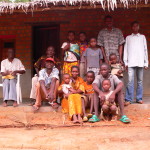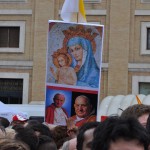The Instrumentum laboris of the next Synod of Bishops / 2
The Instrumentum laboris of the next Synod of Bishops / 3
Hope seems to be the most important message of this document: many families are today experiencing a crisis, so many marriages fall apart, and yet the Church feels called to preach especially the beauty of human love and faith in the fact that – with the help of the grace of Christ – a man and a woman are able to persevere in love and fidelity “to the end”. “Marriage based on exclusive and definitive love becomes the icon of the relationship between God and his people and vice versa. God’s way of loving becomes the measure of human love.” (Deus Caritas Est, 11). Christ is the one who has loved man “to the point of death – even death on a cross.” (Phil 2:8), and allows the husband and the wife to be witnesses of a love so great.
About the description of the different contexts in which Catholics live today, the authors divide the world into two parts: one in which we still have to deal with a rather traditional society, the other where the processes of secularization have worked a radical change in the social context. Europe (and North America) are almost always mentioned in this context, even if sometimes the internal differentiation of the Old Continent is underlined. Communism, which has only caused devastation in many fields in Central and Eastern Europe, has paradoxically strengthened the resistance of the Catholic community against the policy of forced atheism. It also delayed the process of secularization began in the West in the 60s and 70s. We therefore have on the one hand a Europe which rebels against itself, on the other a Europe which is always about to break free from residues of an opposed ideology. This difference can be seen, for example, in relation to the ideology of gender, which in Central and Eastern Europe is perceived – by analogy with Marxism – as an imposition by a foreign culture (111). The 60s and 70s of the last century – as indicated, for their part, by the bishops of the Western countries – have led to a sharp conflict between the generations, as a result of which parents today prefer to avoid controversy with their children, and often leave the responsibility of the education in the faith of their children to religious institutions. While the paradox of Eastern Europe is a reversal of direction in the transmission of faith: it is the children who communicate the faith to their parents (135, 137).
The Episcopal Conferences draw attention to the lack of knowledge of the Church’s teaching on marriage, family, premarital chastity and chastity in marriage. This is true both for many lay people, and for the clergy (11, 12, 26). Some priests who promote instead their own point of view and not the teaching of the Catholic Church cause confusion among the faithful (12). However, if the Church teaching is transmitted “in depth”, it is it is enthusiastically received (13). The resistance to the teachings of the Church often occurs in the absence of an in-depth faith (15), while the practical problems of living according to the principles of the Catholic faith come first, and only after “the couple’s crisis in marriage and the family gradually becomes a crisis in faith”(62).
(1 / to be continued)
Circa la descrizione dei diversi contesti in cui vivono oggi i cattolici, gli autori dividono il mondo in due parti: una nella quale abbiamo ancora a che fare con una società piuttosto tradizionale; l’altra, dove i processi di secolarizzazione hanno operato un cambiamento radicale del contesto sociale. Europa (e America del Nord) sono quasi sempre citate in quest’ultimo contesto, anche se a volte si evidenzia la differenziazione interna del Vecchio Continente. Il comunismo, che nell’Europa centrale e orientale in molti settori ha provocato solo devastazione, paradossalmente ha rafforzato la resistenza della comunità cattolica contro la politica dell’ateismo forzato. Ha anche ritardato il processo di secolarizzazione iniziato in Occidente negli anni Sessanta e Settanta. Abbiamo, dunque, da un lato un’Europa ribelle contro se stessa, dall’altro un’Europa sempre in procinto di liberarsi dai residui di un’ideologia aliena. Questa differenza può essere vista, per esempio, in rapporto all’ideologia del gender, che nell’Europa centrale e orientale è percepita – per analogia con il marxismo – come l’imposizione di una cultura straniera (111). Gli anni ’60 e ’70 del secolo scorso – come indicano, da parte loro, gli episcopati dei Paesi occidentali – hanno portato a un forte conflitto tra le generazioni, conseguentemente al quale i genitori di oggi preferiscono evitare polemiche con i loro figli, e spesso lasciano alle istituzioni religiose la responsabilità dell’educazione nella fede dei loro figli. Mentre il paradosso dell’Europa orientale è l’inversione della direzione nella trasmissione della fede: sono i ragazzi che educano nella fede i loro genitori (135; 137).
Le Conferenze episcopali richiamano l’attenzione sulla scarsa conoscenza della dottrina della Chiesa sul matrimonio, la famiglia, la castità prematrimoniale e nel matrimonio. Questo vale sia per molti laici, sia per il clero (11; 12; 26). Alcuni sacerdoti che promuovono invece il proprio punto di vista e non l’insegnamento della Chiesa cattolica provocano confusione tra i fedeli (12). Tuttavia, se l’insegnamento della Chiesa viene trasmesso “in profondità”, generalmente è accettato con entusiasmo (13). La resistenza agli insegnamenti della Chiesa molto spesso si ha in assenza di una fede approfondita (15), mentre i problemi pratici di vivere secondo i principi della fede cattolica vengono per primi, e solo dopo “la crisi nella coppia, nel matrimonio o nella famiglia si trasforma spesso e gradatamente in una crisi di fede” (62).
(1/continua)
Une espérance pour Europe
Le Document “Les défis pastoraux de la famille dans le contexte de l’évangélisation” – Instrumentum laboris du prochain Synode des Évêques – résume les réponses données au questionnaire envoyé l’année passée aux Églises locales. Plusieurs réponses sont arrivées de la part de l’Europe, mentionnée plus souvent des autres continents dans ce texte. Le document est reparti en trois parties qui traitent, respectivement, l’évangélisation de la famille, la pastorale des familles dans le nouveau contexte culturel, l’ouverture à la vie et la responsabilité des parents pour l’éducation des enfants. L’espoir semble etre le message le plus important de cet document: aujourd’hui plusieurs familles vivent une crise, des mariages s’écrasent, et pourtant l’Église s’engage à prêcher surtout la beauté de l’amour humain et la conviction que – avec l’aide de la grâce de Christ – un homme et une femme peuvent persévérer dans l’amour et la fidélité “jusqu’à la fin”. “Le mariage fondé sur un amour exclusif et définitif devient l’icône de la relation de Dieu avec son peuple et réciproquement: la façon dont Dieu aime devient la mesure de l’amour humain” (Deus Caritas est, 11). Christ est celui qui a aimé l’homme “jusqu’à la mort, et à la mort sur une croix” (Ph 2,8), et qui permet au mari et à l’épouse d’être témoins d’un amour aussi grand.
À propos des différents contextes dans lesquels les catholiques vivent aujourd’hui, les auteurs subdivisent l’univers en deux parties: la première concerne une société plutôt traditionelle; l’autre, une société dans la quelle les processus de sécularisation ont changé radicalement le contexte social. Europe (et Amérique du Nord) sont souvent mentionnées dans cette dernière partie, même si parfois les différences internes du Vieux Continent sont mises en évidence. Le Communisme, qui dans l’Europe centrale et orientale en plusieurs secteurs n’a provoqué que dévastation, a pourtant renforcé la résistance des catholiques face à la politique et à l’athéisme forcé. De plus, il a ralenti le processus de sécularisation commencé en Occident dans les années Soixante et Soixante Dix. Pour cela, nous avons d’un coté une Europe rebelle contre soi-même, de l’autre coté une Europe toujours prête à se libérer des résidus d’une idéologie étrangère. Cette différence peut être vue, par exemple, par rapport à l’idéologie du gender, qui dans l’Europe centrale et orientale est ressentie – par analogie avec le marxisme – comme l’imposition d’une culture étrangère (111). Comme remarqué par les épiscopats des pays occidentaux, les années 60 et 70 ont généré un grand conflit entre générations: suite à cela, aujourd’hui les parents préfèrent éviter les polémiques avec leurs enfants et souvent laissent aux institutions religieuses la responsabilité de l’éducation dans la foi. Tandis que le paradoxe de l’Europe orientale est l’inversion de la direction dans la transmission de la foi: ce sont les enfants a former leurs parents dans la foi (135; 137).
Les conférences épiscopales pointent un manque de connaissance de la doctrine de l’Église sur le mariage, la famille, la chasteté avant le mariage et pendant le mariage. Cela est valable tant pour le laïcat que pour le clergé (11; 12; 26). Quelques prêtres qui mettent en avant leur point de vue à la place de l’enseignement de l’Église, provoquent de la confusion parmi les fidèles (12). Cependant, si l’enseignement de l’Église est transmis “en profondeur», il est en général accepté avec enthousiasme (13).
Très souvent la résistance aux enseignements de l’Église trouve son germe là où la foi manque de profondeur (15), tandis que les questions pratiques liées à la façons de vivre selon la foi catholique sont prioritaires, et seulement après “la crise du couple, dans le mariage ou dans la famille, se transforme souvent et graduellement en une crise de foi” (62).
(1/à suivre)
The Instrumentum laboris of the next Synod of Bishops / 2
The Instrumentum laboris of the next Synod of Bishops / 3
Piotr Mazurkiewicz
Latest posts by Piotr Mazurkiewicz (see all)
- End of life: what is the true right? - 31 dicembre 2014
- Reflect on the fragility - 31 luglio 2014
- The value of marriage - 25 luglio 2014











